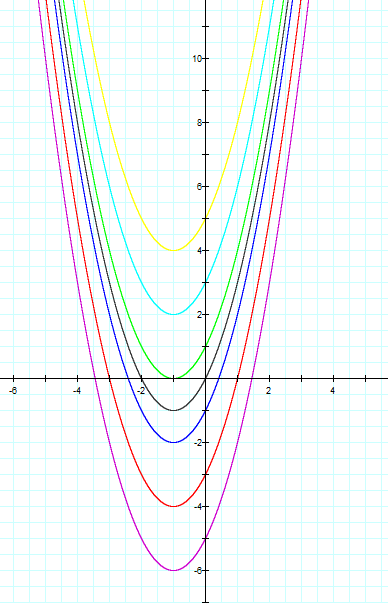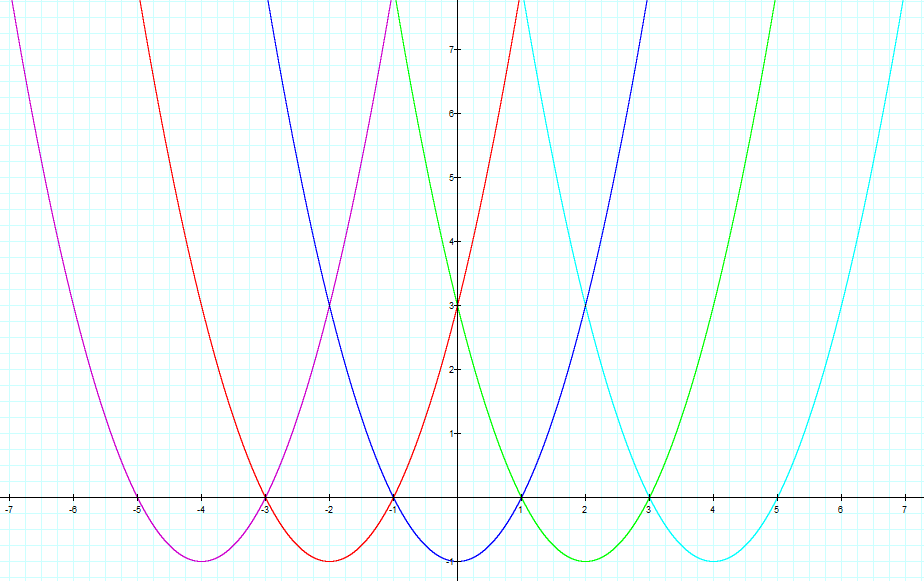

Exploration 2: Oh Where, Oh Where Has My Parabola Gone?
by
Elizabeth Gieseking
In this exploration we will be focusing on the equations of parabolas. A parabola is defined as the set of points which is equidistant from a fixed point called the focus and a fixed line called the directrix. In the figure below, we have a parabola with a focus at (0, p) and a directrix y= - p.
We know all points (x, y) on the parabola are the same distance from the directrix and the focus. Thus we can use the Pythagorean distance formula to derive the equation of a parabola.
If we instead have a vertical directrix, the equation of a parabola with the vertex at the origin is
When the vertex of the parabola is not at the origin, the equations can be translated to the new vertex (h, k).
The two most commonly used forms for the equation of a parabola are the standard form:
and the vertex form:
. In this exploration we will look at what happens to the graph when we vary each of these coefficients and then we will examine the relationship between the two forms of the equations.
The coefficient a: We will start by looking at the simplest equation of a parabola
and we will vary the coefficient a.
We see from this set of graphs that if a is positive, the parabola opens to the top and if a is negative, the parabola opens to the bottom. We also see that as a increases, the parabola rises more quickly, making it appear narrower. This is considered a similiarity transformation. The size of the parabola changes, but not its shape. Since a parabola extends infinitely from the vertex, when we change the value of a, it is if we are zooming in or out from the vertex.
Next we will examine the role of the coefficient b. This set of graphs will use the equation
in which b is varied from -4 to 4.
When b is zero, the graph is centered around the y-axis, with the vertex of the parabola at (0, 1). When b is positive, the graph shifts downward and to the left. When b is negative, the graph shifts downward and to the right. All of the graphs intercept the y-axis at the point (0, 1).
Now we will examine the role of the constant c. We will graph the equation
and vary the constant c from -5 to 5.

From these graphs we see that as c increases, the vertex of the parabola moves upwards along the line x = -1. When c < 1, the parabola crosses the x-axis in two distinct points, resulting in two real zeros for these equations. When c = 1, the parabola touches the x-axis at one point, (-1, 0). Looking at the equation, we see that it is a perfect square.
. Finally, when c > 1, we see that the parabola does not cross the x-axis at all, meaning there are no real zeros.
Both b and c change the location of the parabola but not its size. These transformations are both translations of the parabola.
We will also examine h and k from the vertex form of the equation. The vertex of the parabola is at (h, k). When we vary h, we see that the parabola moves left and right. When h is negative, the vertex of the parabola is left of the y-axis. When h is positive, the vertex is right of the y-axis.

Varying k is very similar to varying c in the standard form of the equation because it results in a vertical shift.
The question now arises, how is the standard form of the equation of a parabola related to the vertex form? We will now look at how we can convert the standard form to the vertex form by completing the square.
Thus in our vertex form,
, we see that
. Although it takes some effort to convert an equation in standard form to vertex form, it provides many benefits.
The shapes of all parabolas are the same - the only things that change are the vertex and the scaling factor, a. Thus, a parabola in vertex form is much easier to graph. Once you have the vertex, you can simply step up the sides to find the next points.
These equations also help explain the effect of changing b in the standard form of the quadratic equation. When we changed a, only the size of the parabola was affected. When we changed c, only the vertical position of the vertex changed. However, when we changed b both the horizontal and vertical positions of the vertex were affected. We see in our equations above that both h and k are affected by a change in b, resulting in both horizontal and vertical shifts of the graph.
The vertex form can also make it easier to find the zeros of the quadratic.
From this equation, we see that x will have no real roots if k > 0, one real root if k = 0, and two roots if k < 0.